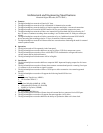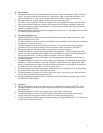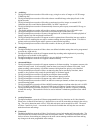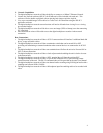G. Archiving:
1. The digital multiplexer recorder will be able to copy a single or series of images to a SCSI Iomega
250MB-zip disk.
2. The digital multiplexer recorder will be able to detect a modified image when played back via the
digital recorder.
3. The digital multiplexer recorder will be able to continuously archive images to external SCSI
OnStream tape drives and Hewlett Packard DDS-2 or DDS-3 tape drives.
4. The digital multiplexer recorder will automatically detect on power-up any connected SCSI copy or
archive device.
5. The digital multiplexer recorder will provide a setting to automatically eject a full archive tape.
6. The digital multiplexer recorder will be able to record and archive at the same time.
7. The digital multiplexer recorder will come with application PC software that will enable playback of
images copied to zip disk and played back from PC.
8. The digital multiplexer recorder will support an archive pointer that will mark the last area copied to
the archive device enabling the next tape to continue arching the next segment of data. This archive
pointer can be reset allowing the archive process to start from the beginning.
9. The digital multiplexer recorder will be able to archive all data or just alarm recorded.
H. Scheduling:
1. The digital multiplexer recorder will have three user defined schedule settings that can be programmed
to record day, night activity.
2. The digital multiplexer recorder will support normal day recording and at night activity recording
allowing the user to double its disk capacity.
3. The digital multiplexer recorder will be able to use user defined recording modes.
4. The digital multiplexer recorder will support scheduled arching.
I. Alarm and Relays:
1. The digital multiplexer recorder will support separate or all alarm recording. In separate, cameras with
alarms will only record. In all recording, when an alarm is activated all cameras will record. In all
alarm recording, camera priority will enable cameras with high and low priority to be identified.
2. The digital multiplexer recorder will have an alarm log that can be searched by time date, alarm
number or also perform a skip search for quick display of all alarms logged.
3. The digital multiplexer recorder will support pre and post alarm recording.
4. The digital multiplexer recorder will have an alarm contact input per camera.
5. The digital multiplexer recorder will support copy and or archive of alarms.
6. The digital multiplexer recorder will have an alarm in contact per channel, an alarm out to support an
external warning signal.
7. The digital multiplexer recorder will have MODE terminal outputs to indicate when the unit is in REC.
PLAY, POWER, and REMAIN. An output LOW signal will indicate if mode signal is interrupted.
8. The digital multiplexer recorded will have a CALL terminal output to indicate % capacity remaining
of hard disk storage. This terminal will also be used to indicate if a hardware problem occurs within
the unit.
J. Activity Detection:
1. The digital multiplexer recorder will feature programmable activity detection on all video channels.
When active is turned ON and activity is detected, the event will be recorded as an alarm in the activity
log. The activity detection mask will be 12X10 and each pixel can be turned ON or OFF. The mask
will have 5 sensitivity levels. A test mode will be also be available that will help the user test their
needed mask area and settings.
K. Password:
1. The digital multiplexer recorder will have User Security Access lock modes and Password codes. The
LOCK function will lockout customers from all front panel controls. The Password function will also
lock out all users from making any changes to the units current running conditions and from making
any changes to the units programmed menu settings.
3






